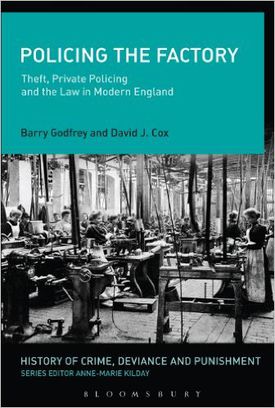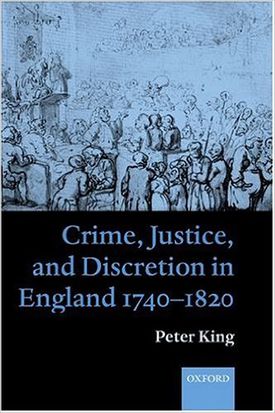British Criminal and Legal History Top Ten Booklist
Despite notions to the contrary, legal history can extraordinarily fascinating. Legal history explores the conflicts that arise from civilization. A deft legal historian can look at the most bare bones court record or account and seemingly bring the trial to life. These books have been chosen because of their fantastic narration, informative overviews, and consideration of new historical themes within the field. For example, Shani D’Cruz and Louise Jackson add to our understanding of women's experiences before the law. And Richard Ward brings our awareness to how media can shape popular attitudes concerning crime.
If you're even remotely familiar with the field of British criminal and legal history, no doubt you've seen John Beattie’s Crime and the Courts in England, 1660-1800 which is why it's not on this list. This is considered to be the go-to reference for scholars, as it touches upon a wide range of crimes and walks the reader through court proceedings. It's a hefty work that attempts to leave nothing out. That being said, it's a good source to consult before moving on to more detailed analysis of the specific topic you're interested in. That's where our top ten booklist may be helpful. While several of these books provide a general overview of the field that may be useful to those just beginning to study, other works dig deeper into very specific historical themes or questions.
Top Ten
1. Andrew, Donna and Randall McGowen. The Perreaus and Mrs. Rudd: Forgery and Betrayal in Eighteenth-Century London (University of California Press, 2001) While many of the books on our list deal with broad time periods and criminal themes, this engaging work reads like a contemporary criminal mystery. The Perreaus, twin brothers, and the wife of one of them, Mrs. Rudd, were accused of forgery in 1775. Along with the narrative retelling of the exciting case, Andrew and McGowen ask larger historical questions. For example, why was forgery a capital crime? How did fashion and style impact the court's perception of the defendants? A boring history of crime this is not.
2. Cox, David and Barry Godfrey. Policing the Factory: Theft, Private Policing and Law in Modern England (Bloomsbury, 2014). Much of British criminal history focuses on victims and offenders before various courts of law. Cox and Godfrey bring to light a variety of workplace thefts and discuss how the law operated within the private work force. They build upon rich sources that include newspaper comments, case studies, memoirs, and archival statistics. Cox and Godfrey also analyze what these localized legal encounters meant for citizens in a modern England.
3. D’Cruz, Shani and Louise Jackson. Women, Crime and Justice in England Since 1660 (Palgrave Macmillan, 2009). Women in the courts and as part of the legal system have been greatly overlooked by historians of crime and law. D'Cruz and Jackson's work is a solid addition. They address crimes largely associated with women (prostitution, infanticide, witchcraft) and explore the changing nature of feminism in England. D'Cruz and Jackson draw on autobiographies, popular media, and court accounts. People interested in women's political activism and protest movements will enjoy the scholarship on this more recent history.
4. Emsley, Clive. " Crime and Society in England, 1750-1900 (Pearson Longman, 2013) Most students of criminal history will be familiar with some of Emsley's work. This book was originally published in 1986 and was a detailed analysis of how society responded to crime, criminal behaviors, and developed a police force. A revised fourth-edition Crime and Society has recently been published. This newest edition builds on Emsley's discussion of a criminal class in English history by including women. Specifically, it examines how contemporary expectations of gender influenced criminal proceedings.

5. Gray, Drew D. Crime, Policing and Punishment in England, 1660-1914 (Bloomsbury Acadmic, 2016) Regardless of if you're new to the field of criminal and legal history or you're familiar with the subject, you'll find something useful and engaging in Gray's book. The book is divided into two parts. The first deals with specific themes (like juvenile crime and gender and crime) while the second part deals with the development of the justice system. Helpfully, Gray offers considerations for future research in the field.
6. Kilday, Anne-Marie and David Nash. " Histories of Crime: Britain 1600-2000 (Palgrave Macmillan, 2010). Readers interested in such crimes as marital cruelty, infanticide, white-collar convictions, as well as the death penalty will probably find an essay of interest in Kilday and Nash's collection. The work does a good job of relating a case study in detail for each type of crime that's covered. This is a useful introduction to a variety of crimes, but it tells a larger story of how British society viewed criminals and criminal behavior over four-hundred years.
7. King, Peter. Crime, Justice, and Discretion in England, 1740-1820 (Oxford University Press, 2000) Since King is such a prolific historian in this field, we chose one of his works that contributes to social criminal history. By focusing on a somewhat narrow time period, King is able to give detailed descriptions of trail experiences from pretrial processes to sentencing and punishment. Although he is a social historian, King downplays the importance of women in the courtroom.
8. Lemmings, David, ed. Crime, Courtrooms and the Public Sphere in Britain, 1700-1850 (Routledge, 2012) If you're looking for a variety of respected viewpoints on the changing nature of criminal proceedings, look to Lemmings's collection of historical essays. Most of the contributions rely on published accounts of trials, so the overall theme of the book is the rise of print culture and how it shaped public perception about the proceedings. Through these selections, Lemmings argues that print culture supported the prosecution while judging the morality of those on trial.
9. Palk, Dierdre. Gender, Crime and Judicial Discretion, 1780-1830 (Royal Historical Society/Boydell Press, 2006) Palk has completed some of the more recent work on gender and the law. Her study highlights three main types of theft (shopliftin, pickpocketing, and uttering, or forgery). Palk does a good job of comparing the treatment and experience between male and female offenders. She largely focuses on defendants before the court, rather than their victims.
10. Ward, Richard. Print Culture, Crime and Justice in 18th-Century London (Bloomsbury Academic, 2016) It's understood court records and accounts became more detailed as time went on. In fact, the early-18th century saw a fascination with printed accounts of criminals and their trials. While many histories rely on the trial accounts themselves, Ward delves into newspapers, periodicals, and graphic prints as well as the trial proceedings and accounts of those ministering to the accused. For anyone interested in how criminals and crime were presented to a larger public, Ward's book is essential. Admin, Jgibson and EricLambrecht


